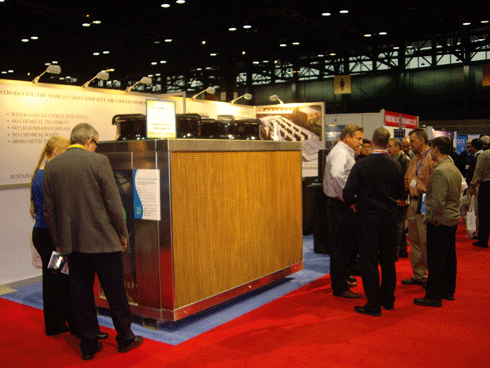A Factor 5 water saving with a cooling systems innovation
Mike Smith, Karlson Hargroves and Cheryl DeshaThe Natural Edge Project
Melbourne-based manufacturer Muller Industries
Australia’s new cooling system saves 80 per cent of the average water
usage in commercial office buildings that use water-based cooling
towers.

|
|
The 3C Cooler, from Muller Industries Australia, has been attracting great attention at both trade expos and installation sites.
Credit: Muller Industries Australia
|
Why is this important? One million water towers are
used in such buildings globally as part of their cooling systems – this
innovation eliminates the need for any water cooling towers at all,
saving water and reducing health risks.
Many commercial and public buildings, and in
particular larger buildings, have water cooling systems which use
cooling towers. They can account for up to 30 to 40 per cent of a
building’s water use.
Water cooling systems process and remove heat from
the building, essentially by evaporating water. The evaporation of
1 litre of water absorbs more heat than any other liquid in the same
conditions, which is why water-based cooling towers are installed on so
many buildings. In an office with 10 000 m2 of floor space, roughly 2 megalitres of water will be evaporated each year using water cooled systems.
The main alternatives to water cooling systems are
dry cooling systems, which do not use any water at all but tend to use a
lot more energy. Given that it is important in a carbon constrained
world to reduce energy usage, dry cooling systems are no longer going to
be a viable alternative in commercial or office buildings.
A new hybrid dry air/water cooling system, developed
by Muller Industries Australia, enables reductions in water usage of
around 80 per cent while still being almost as energy efficient as water
cooled systems. The Muller 3C Cooler uses air to cool in ambient
temperatures, only uses water under extreme conditions, and is designed
so that it can be retrofitted, easily replacing water cooled systems and
their water cooling towers.

|
|
The main Royal Women’s Hospital building in Melbourne is now cooled by 3C units.
Credit: Muller Industries Australia
|
The cooler consumes 30 per cent less energy than
other air-conditioning systems, and uses only slightly (5–10 per cent)
more energy compared to water cooled systems. It also delivers a
sizeable 7 decibel (dBA) noise reduction.
What’s more, cooling towers are open systems which make ideal conditions for the propagation of the Legionella
bacteria, the cause of Legionnaires’ disease, which can be fatal. The
3C Cooler, on the other hand, is a closed system, thus eliminating this
risk. It therefore provides hospitals and other more ‘high risk’ public
buildings with the security of knowing that their air-conditioning
system dramatically reduces the chance of Legionella infection.
Currently there are over 600 installations of the
Muller 3C Coolers across Australia and others in the United Kingdom,
France and Asia. The cooler has been used in a range of applications,
including hospitals, commercial office buildings and government
buildings.
Another innovation, the Muller Dricon, is designed
to be used instead of evaporative condensers to supply cool air for
refrigeration. Coles Supermarkets in Australia are using this technology
to reduce water usage in their refrigeration air cooling systems.
The Muller 3C and the Dricon can use rainwater and
greywater, enabling them to further reduce commercial buildings’ water
usage from mains water.
Melbourne University’s new Faculty of Economics and
Commerce building is an example of this approach. They claim that the
12-storey building delivers carbon reductions of 73 per cent and water
use reductions of up to 90 per cent. The building achieves this through
reducing cooling demand by utilising natural ventilation and chilled
beam cooling technology, and by the installation of Muller 3C Coolers
combined with rainwater harvesting and greywater reuse.
No comments:
Post a Comment